Have you ever been in the woods at night and heard a sound like an owl’s call? Many birds, not just owls, make sounds that can be mistaken for owls. From the whimsical whip-poor-will to the eerie yodels of the common loon, these birds add charm to the night.
But why do these birds copy owl sounds? And how can we tell them apart from real owls? Let’s explore these questions and learn more about these fascinating birds.
Key Takeaways
- Many bird species, including the Common Nighthawk, Eastern Screech-Owl, and Barred Owl, produce sounds that can be mistaken for owl calls.
- Birds mimic owl sounds for reasons like protection, communication, and habitat overlap with owl species.
- Understanding visual cues, pitch, and recording bird calls can help differentiate between owl and non-owl vocalizations.
- Threats like habitat loss and light pollution impact both owl and mimicry species, highlighting the importance of bird conservation.
- Exploring the diversity of bird sounds can enhance our appreciation for the natural world and the complex behaviors of our feathered friends.
Why Do Birds Mimic Owl Sounds?
Birds imitating owl sounds is a fascinating part of their behavior. Some use bird mimicry to protect themselves from predators. Others use owl call imitations to attract mates or mark their territory in nocturnal bird communication.
Mimicry for Protection and Communication
Birds living near owls may adopt the owls’ calls. This makes their sounds similar to the owls’, like hoots and screeches. This can help protect them from predators that think they are owls.
Some birds also use owl sounds to communicate. They make owl-like calls to attract mates or show off their territory. This makes them seem more powerful, helping them in finding mates and resources.
Habitat Overlap and Learning Calls
Living near owls helps birds learn owl sounds. They watch and listen to the owls, adding these sounds to their own bird vocal behavior. This shows how birds can learn and adapt from each other.
This learning shows how skilled birds are at bird mimicry. It helps us understand how they communicate with each other.
Notable Bird Species That Sound Like Owls
Several bird species are known for their calls that sound like owls. These birds that sound like owls, or owl impersonators, have this talent for many reasons. They use it for defending their territory and to communicate during mating.
Eastern Screech-Owl
The Eastern Screech-Owl is a well-known example. It makes sounds like whinnying, trilling, and monotone hooting. These sounds can be mistaken for other birds. This helps the Eastern Screech-Owl mark its territory and communicate in its ecosystem.
Common Nighthawk
The Common Nighthawk is another bird that sounds like an owl. It’s not an owl but has a call that sounds similar. This call helps it communicate and defend its territory as it flies through the night looking for food.
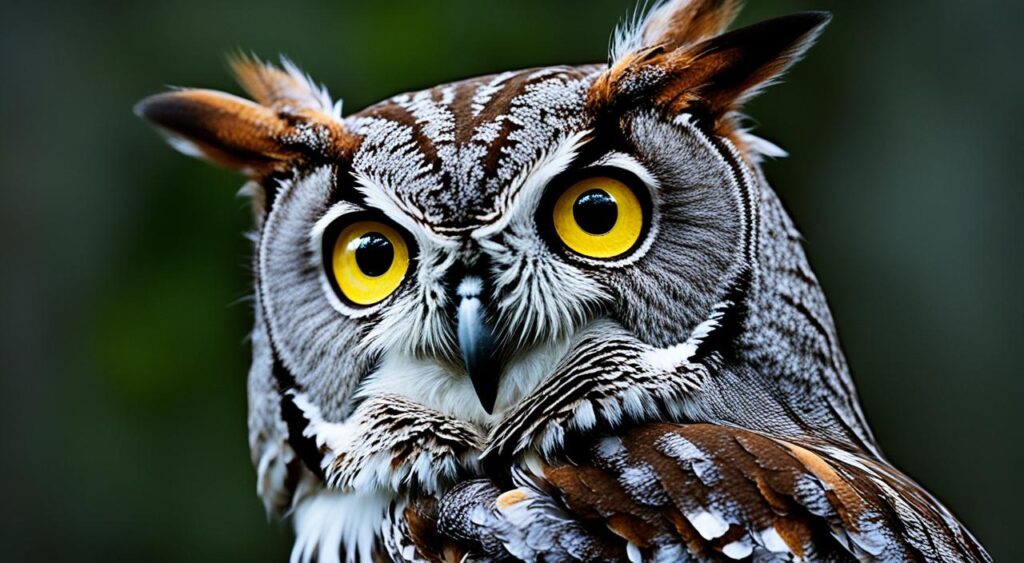
These birds that sound like owls show how birds adapt and survive. By understanding why they make these sounds, we learn more about bird communication. It’s a fascinating look into the world of bird calls.
Mourning Dove: The Owl Impersonator
The Mourning Dove is a bird that can imitate owl calls very well. It makes soft sounds at dawn and dusk that sound like owls. This makes it hard to tell apart from larger birds.
There are about 350 million Mourning Doves in the U.S. They are known for their mimicry and are important in nature. They eat mostly seeds, which helps spread seeds around.
Their sounds help protect them from predators. By sounding like owls, they can scare away threats. This trick is very useful where they live near owls.
Knowing how to recognize the Mourning Dove’s calls helps bird lovers and nature fans. It lets them better understand the variety of birds around them. This way, they can appreciate the beauty of nature more.
“The Mourning Dove’s cooing is a beautiful and haunting sound that can transport you to a serene, natural setting. Its ability to mimic owls is a testament to the incredible diversity and complexity of avian vocal communication.”
The Mourning Dove’s sounds might confuse some people at first. But these sounds are key to its survival and show how birds communicate. By learning about the Mourning Dove’s sounds, we can understand nature better and appreciate our bird friends more.
Eurasian Collared-Dove: Confusing Call
The Eurasian Collared-Dove is known for its owl-like vocalizations. It makes a sound like “coo-COO-oo” that can be mistaken for an owl’s hoot. This avian vocal similarity can confuse people and bird sound identification experts alike. The dove’s calls sound a lot like those of larger, night birds.
In recent years, the Eurasian Collared-Dove has spread widely across the United States. Now, it’s found all over the country. This means more people are hearing its unique calls. Learning to tell the Eurasian Collared-Dove’s call apart from an owl’s can help people understand the different birds around them.
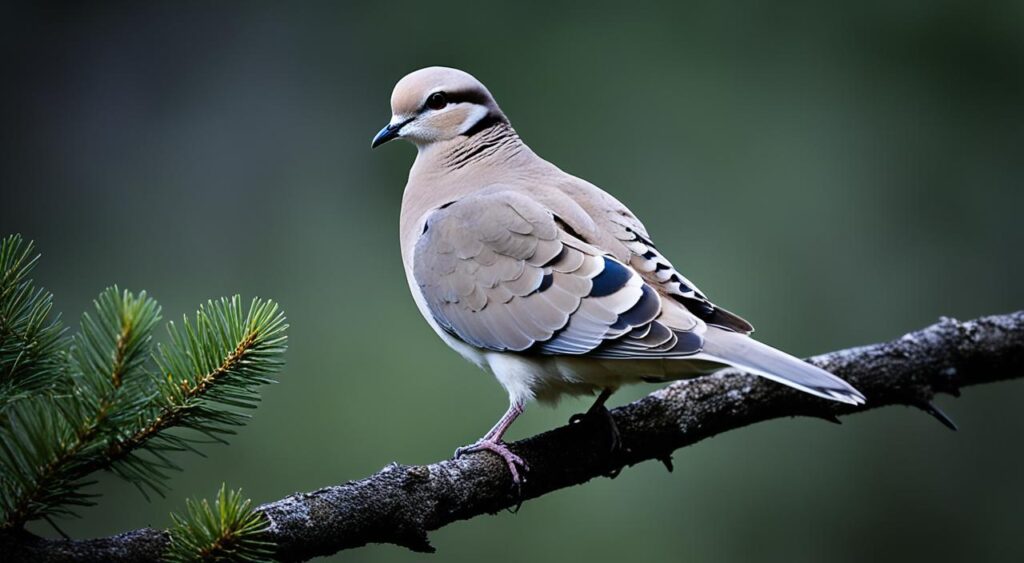
The Eurasian Collared-Dove’s call sounds a lot like an owl’s, which can be confusing. But, knowing how this dove sounds can help people recognize and enjoy the avian vocal similarity in their area.
Northern Mockingbird: The Master Mimic
The Northern Mockingbird is famous for mimicking other birds, including owls. It can learn and copy up to 200 different songs. These birds add owl-like sounds to their songs, making it hard to tell them apart from real owls.
They sing a lot at night, especially when it’s breeding season or on bright moonlit nights. This adds to the confusion about their calls and those of owls.
Diverse Repertoire and Singing Habits
Northern Mockingbirds don’t just imitate birds; they mimic many sounds, like dogs, cats, frogs, and even car alarms. Their songs can go from 20 seconds to hours long. Unmated males sing the most and sing at night, especially when the moon is full.
“Northern Mockingbirds can mimic up to 200 different sounds in their lifetime.”
Females sing too, but not as loudly or often as males. They sing in the autumn and in a softer voice. Their songs mix mimicked sounds and their own unique calls. They often mimic birds like the Carolina Wren and the Northern Cardinal.
Knowing about the Northern Mockingbird‘s singing habits and mimic skills helps birdwatchers tell it apart from the birds it imitates. The reasons why they mimic and how they learn these sounds are still a mystery. Yet, their amazing vocal talents keep fascinating bird lovers and others who watch them.
Yellow-breasted Chat: Weird and Wonderful
The Yellow-breasted Chat is a standout among birds for its owl-like calls. It’s known for its “weird and wonderful” sounds. These include cackles, clucks, whistles, and hoots that sound like owls.
This bird is not night active but sings at night during breeding season. Up to 40% of Yellow-breasted Chats can mimic owl-like sounds. These sounds make up to 25% of their night singing.
The Yellow-breasted Chat‘s calls are a mystery to many. These avian vocal acrobats can imitate owls. This makes them “weird and wonderful.”
This bird’s ability to mimic owls adds to its reputation. It’s a key part of its bird sound complexity and avian vocal diversity. It’s a favorite among those who love the natural world.
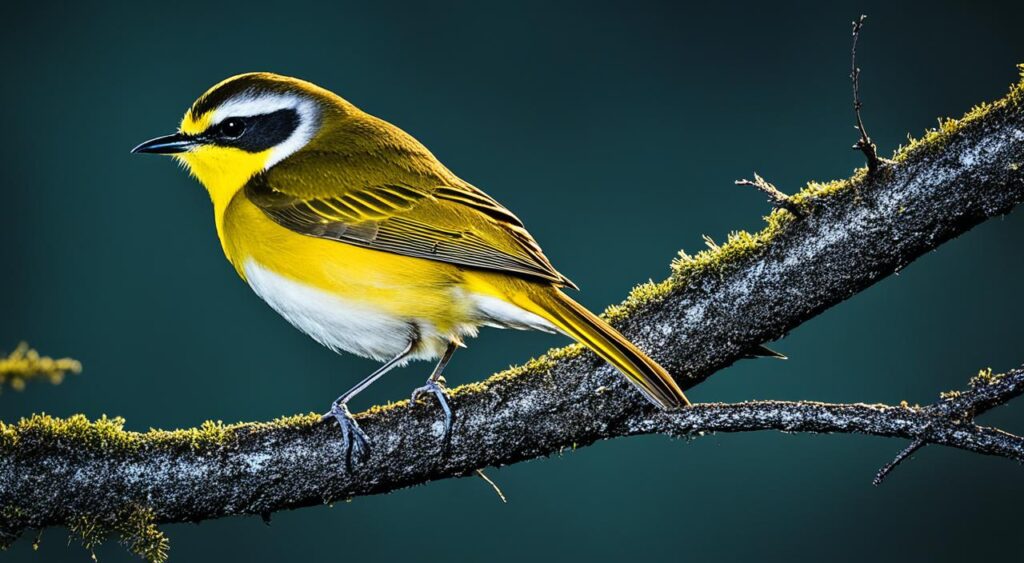
“The Yellow-breasted Chat is a true vocal virtuoso, blending its own melodious songs with uncanny imitations of owls and other birds. Its ‘weird and wonderful’ vocalizations are a testament to the incredible diversity of avian sound production.”
The Yellow-breasted Chat enchants with its night songs and daytime melodies. Its complex and compelling calls often include owl-like hoots and cries. This makes it a unique and captivating bird.
Barred Owl: Inimitable “Who-Cooks-For-You”
The Barred Owl is famous for its “who-cooks-for-you” call. This call is a key sound of the species. But, it doesn’t just make this sound. It also makes gurgles, caws, hoots, and cackles.
These sounds, along with its silent flight feathers, make it a top hunter at night. It can sneak up on its prey with ease.
Hunting Techniques and Range Expansion
The Barred Owl’s range has grown from its old home in eastern North America to the Pacific Northwest. Now, more people hear its calls. This shows how adaptable the species is and how important it is to know about Barred Owls and other owl-like birds.
The Barred Owl’s nocturnal bird hunting skills and unique owl vocalizations make it a top predator at night.
“The Barred Owl’s ‘who-cooks-for-you’ call is a sound that has captured the imagination of many, becoming a beloved part of the natural soundscape in much of North America.”
The Barred Owl is still adapting to new environments and moving into new areas. Its special sounds will keep enchanting people who hear them at night.
Common Loon: Haunting Yodels and Wails
The Common Loon’s haunting yodel is unforgettable. But this large waterbird makes many sounds, not just the yodel. At night, they make cackling tremolos and wolf-like wails. These sounds are just as haunting as their daytime yodels.
The Common Loon is famous for its beautiful avian vocalizations. Up to 75% of their calls happen at night. These nocturnal bird calls help them talk to other loons and mark their territory. Their night sounds make their natural homes even more magical.
“The haunting calls of the Common Loon are a quintessential part of the northern wilderness experience.”
However, Common Loon numbers in the northern U.S. have gone down. This is because of pollution and wind turbine collisions. Loon conservation is key to saving this unique bird. They depend on the health of the lakes and rivers they live in.
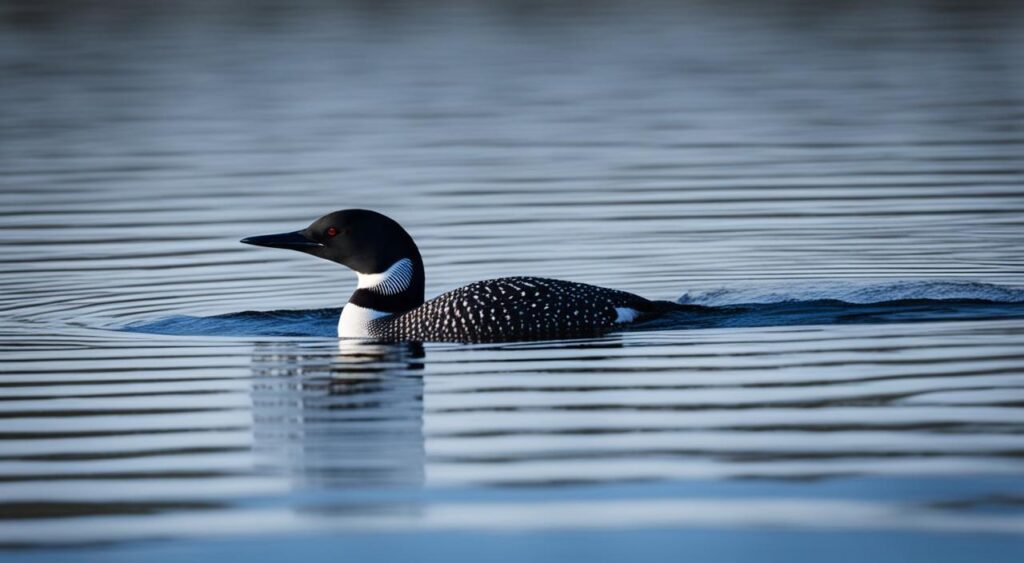
Protecting the Common Loon’s homes and paths is important. This helps keep the beautiful sounds of nature alive for future generations. The loon’s nocturnal bird calls show us the beauty of nature. Keeping them safe is vital for the balance of nature.
bird that sounds like an owl
Listening for bird calls that sound like owls is exciting for birdwatchers and nature lovers. It takes a mix of listening skills and knowing about bird sounds to get it right.
Recording the sounds and comparing them to known owl calls is a good move. This helps tell apart different owl sounds and birds that copy them. Paying attention to the pitch, number of hoots, and how they flow together is also key.
Distinguishing Owl Sounds from Avian Mimics
Watching the bird closely can also help. Noting its size, color, and actions can tell you if it’s a real owl or just an imitator. This way, birdwatchers can learn about the many night and twilight birds that make unique sounds.
By improving your listening skills and getting to know owls and imitators, you can better identify bird calls, distinguish owl sounds, and enjoy the bird sound recognition skills. These are important parts of avian vocal patterns.
“Recognizing the diverse array of bird calls that resemble owl hoots is a captivating and rewarding pursuit for nature enthusiasts.”
Upland Sandpiper: Ethereal Melody
In North America’s vast grasslands, a special bird sings a beautiful song. The Upland Sandpiper makes a sound like an owl, mixing wild trilling with a high-pitched whistle. This creates a magical music that fills the night during breeding season.
Threats and Conservation Efforts
The Upland Sandpiper’s numbers are going down because of habitat loss. Their homes in the grasslands are being turned into farmland. To save these birds, we need to work on sustainable farming, bring back old grasslands, and cut down on herbicide use.
This bird’s song shows how beautiful and diverse North America’s grasslands are. By helping to protect grassland birds, we can keep their songs alive for the future.
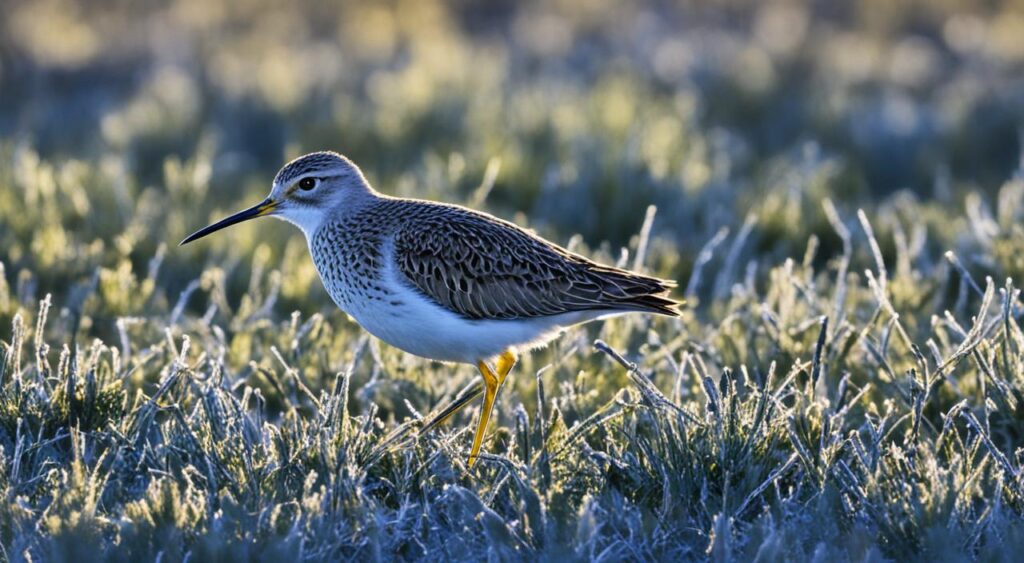
“The Upland Sandpiper’s ecstatic song, which combines wild trilling with an ethereal whistle, is a mesmerizing example of a bird call that can be easily mistaken for an owl’s.”
European Robin: Mistaken for Nightingales
The European Robin is known for its red breast. But, it’s also famous for singing a lot at night. This often makes people think it’s the Nightingale, which is actually more famous.
The European Robin sings from dusk till dawn, not just at night. It’s not strictly a night bird. It sings in twilight and can even answer calls from true night birds. This is because of light pollution and urban noise, which mess with birds’ singing habits.
“The European Robin’s nocturnal singing often leads to it being mistaken for the more renowned Nightingale, highlighting the complexity of avian sound identification.”
Robins and Nightingales live in the same places and sound similar. This makes it easy to get them mixed up. Knowing how different birds sound is key for identifying them and protecting them.
Robins are great at living in cities and suburbs. But, this makes it easy to confuse their night songs with the Nightingale’s. By understanding the Robin’s unique sounds, we can appreciate how diverse birds are.
Reed Warblers: Extensive Night Singers
Many species of reed and sedge warblers in the genus Acrocephalus love to sing at night, especially when they’re looking for a mate. These small birds eat insects and live in Europe, Asia, and parts of Africa. Their loud songs fill the night air, making them a big part of the nocturnal soundscape in their homes.
The great reed warbler is famous for singing for up to 20 minutes straight. Its songs can be heard from far away. Learning about these birds’ nocturnal singing habits helps us understand how different songbirds live together in the same places.
“The great reed warbler is renowned for its ability to sing for up to 20 minutes at a time, with its vocalizations carrying for impressive distances.”
Reed warblers aren’t the only ones who sing at night. Birds like the nightingale also sing in the dark. They use their songs to talk to each other, protect their territory, and find a mate. By studying these avian vocal behaviors, we learn more about how birds communicate and survive.
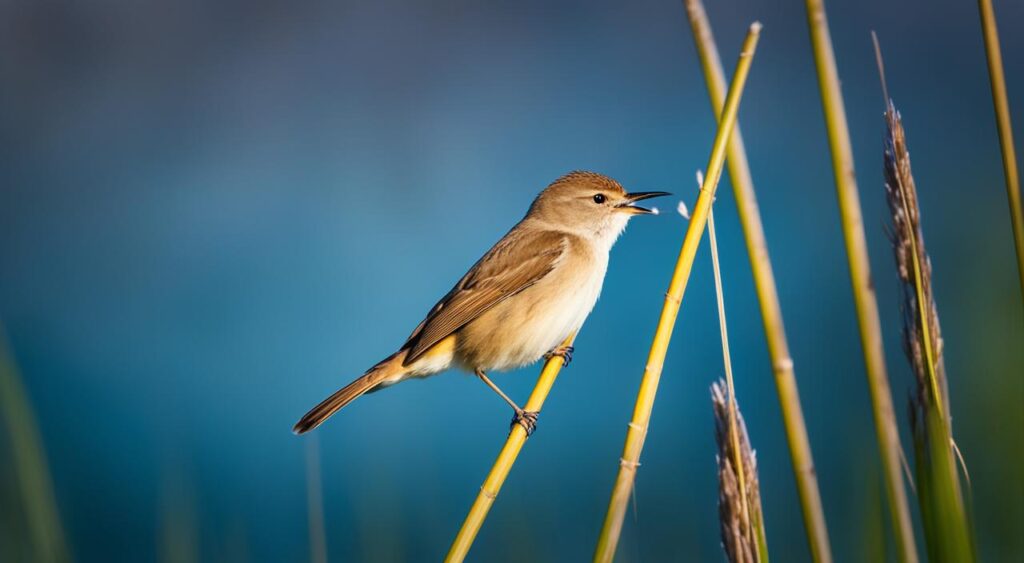
- Reed Warblers are known for their extensive nocturnal singing during the breeding season.
- Their powerful, far-reaching calls contribute to the nocturnal soundscape in their habitats.
- Understanding the nocturnal singing habits of reed warblers can help birdwatchers appreciate the diverse avian vocal behavior in shared environments.
- Other birds, such as the nightingale, also exhibit extensive nocturnal singing behavior.
Night Herons: Nocturnal Hunters
Several species of night herons are silent hunters, using their great night vision to catch small water animals. The Black-crowned Night Heron is a well-known example, found in North and South America, Africa, and Eurasia. It makes sounds like croaks and barks, adding to the mysterious feel of wetlands at night.
The Black-crowned Night Heron is a medium-sized bird that stands about two feet tall and has a wingspan of around 44 inches. Young birds look like adults and grow up in about two years. These night herons make unique sounds, like the “qu-arck” call of adult males at night, and the “qu-ook” call of females and young birds.
Learning about nocturnal hunting behaviors and night herons shows us how diverse life is in both day and night worlds. By understanding how these birds survive in the dark, we appreciate the natural world more deeply.
FAQ
What is the significance of birds that sound like owls?
Many birds make sounds that can be mistaken for owls. Even though owls are known for their night calls, these birds add charm to the night. They help us understand how nocturnal and twilight birds communicate and survive.
Why do birds mimic owl sounds?
Birds may mimic owl sounds to protect themselves from predators. They also use these sounds to attract mates or mark their territory. Sometimes, birds living near owls learn to make similar sounds by accident.
What are some bird species known for their owl-like vocalizations?
Species like the Eastern Screech-Owl, Common Nighthawk, Mourning Dove, Eurasian Collared-Dove, and Northern Mockingbird make sounds like owls. They use these sounds for different reasons, such as defending their territory or finding a mate.
How can birdwatchers and nature enthusiasts identify bird calls that sound like owls?
To identify owl-like sounds, try recording them and compare them to real owl calls. Notice the pitch and how many hoots there are. Also, look at the bird’s appearance. Getting to know these details helps in identifying different birds at night or during twilight.
What other bird species are known for their nocturnal or crepuscular vocalizations?
Besides the ones mentioned, birds like the Upland Sandpiper, European Robin, and certain warblers and night herons are also vocal at night. Learning about their sounds can give us a deeper understanding of the night’s bird songs in different places.
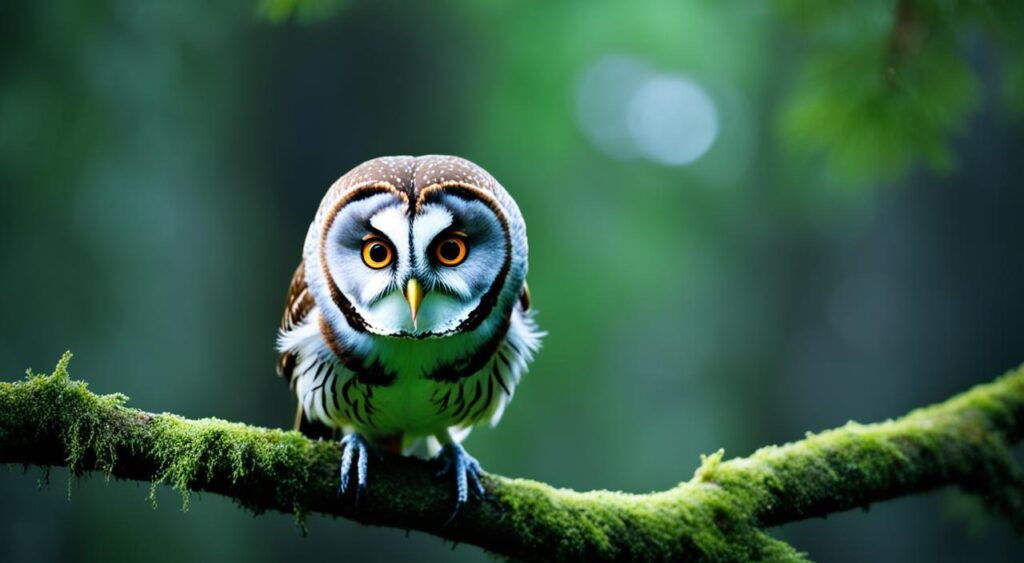

гарантия при продаже аккаунтов https://birzha-akkauntov-online.ru/
услуги по продаже аккаунтов магазин аккаунтов
продать аккаунт платформа для покупки аккаунтов
площадка для продажи аккаунтов маркетплейс аккаунтов
магазин аккаунтов социальных сетей prodat-akkaunt-online.ru/
маркетплейс аккаунтов биржа аккаунтов
маркетплейс аккаунтов соцсетей магазин аккаунтов
Website for Selling Accounts Account marketplace
Account Trading Online Account Store
Account exchange Account Market
Profitable Account Sales Profitable Account Sales
Buy Pre-made Account https://accountsmarketplacehub.com
Guaranteed Accounts https://socialaccountsstore.com/
Buy Account Gaming account marketplace
Website for Selling Accounts Account trading platform
Account exchange Website for Buying Accounts
Gaming account marketplace Sell accounts
Account Store Website for Buying Accounts
account sale secure account purchasing platform
website for selling accounts sell account
account exchange account trading platform
purchase ready-made accounts https://buyaccountsdiscount.com/
account catalog website for selling accounts
account trading marketplace for ready-made accounts
account trading service accounts for sale
guaranteed accounts account trading platform
find accounts for sale verified accounts for sale
online account store social media account marketplace
account buying platform account exchange
ready-made accounts for sale account purchase
database of accounts for sale gaming account marketplace
account selling service accounts marketplace
accounts market account sale
account acquisition ready-made accounts for sale
account buying service sell pre-made account
account acquisition account trading platform
buy pre-made account website for selling accounts
buy pre-made account purchase ready-made accounts
website for buying accounts account trading service
guaranteed accounts website for buying accounts
account selling platform buy account
account sale sell accounts
account market account buying platform
secure account sales accounts for sale
database of accounts for sale profitable account sales
find accounts for sale account trading platform
profitable account sales https://accounts-offer.org
account market https://accounts-marketplace.xyz/
marketplace for ready-made accounts https://buy-best-accounts.org
purchase ready-made accounts https://social-accounts-marketplaces.live/
secure account sales account marketplace
account store https://social-accounts-marketplace.xyz/
account market https://buy-accounts.space
ready-made accounts for sale account marketplace
sell pre-made account accounts market
account trading https://social-accounts-marketplace.live
marketplace for ready-made accounts https://buy-accounts.live
account buying platform https://accounts-marketplace.online
accounts marketplace https://accounts-marketplace-best.pro
магазин аккаунтов https://akkaunty-na-prodazhu.pro
покупка аккаунтов rynok-akkauntov.top
биржа аккаунтов https://kupit-akkaunt.xyz
купить аккаунт akkaunt-magazin.online
маркетплейс аккаунтов akkaunty-market.live
продать аккаунт kupit-akkaunty-market.xyz
маркетплейс аккаунтов https://akkaunty-optom.live/
биржа аккаунтов https://online-akkaunty-magazin.xyz/
покупка аккаунтов https://akkaunty-dlya-prodazhi.pro
маркетплейс аккаунтов соцсетей купить аккаунт
facebook ad account buy https://buy-adsaccounts.work
facebook account buy buy facebook account for ads
cheap facebook account https://buy-ad-account.top
buy facebook account for ads cheap facebook accounts
fb accounts for sale https://ad-account-buy.top
facebook ads account for sale https://buy-ads-account.work
buy facebook accounts for advertising https://ad-account-for-sale.top
buy fb ad account buy facebook accounts
buy old google ads account buy google agency account
buying facebook ad account https://buy-accounts.click
buy google adwords accounts buy aged google ads account
google ads accounts buy google ads invoice account
adwords account for sale buy google ads account
google ads agency account buy https://buy-account-ads.work
google ads reseller https://buy-ads-agency-account.top/
buy google ads threshold account https://sell-ads-account.click